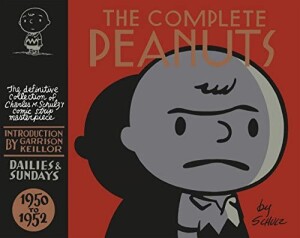 Subtitled “The Definitive Collection of Charles M. Schulz’s Comic Strip Masterpiece,” this project is set to run for 12 years, at two volumes per annum until every daily strip from the master’s hand is available in a matched set of hardcover books. What a mammoth undertaking! And what a glorious tribute to the enduring qualities of these four panel ink sketches of little kids with round heads!
Subtitled “The Definitive Collection of Charles M. Schulz’s Comic Strip Masterpiece,” this project is set to run for 12 years, at two volumes per annum until every daily strip from the master’s hand is available in a matched set of hardcover books. What a mammoth undertaking! And what a glorious tribute to the enduring qualities of these four panel ink sketches of little kids with round heads!
Designed by Canadian cartoonist Seth, the books have a distinctive look and appropriate heft, as though you are holding something important in your hands. I first saw the books last summer in New York City. We stayed in a hotel just off Broadway, and out the back door was a huge comic book store. I spent many free moments browsing through the racks in Jim Hanley’s Universe. Then I saw Volume 1 of The Complete Peanuts. It was signed by designer Seth, and featured a drawing of one of his own characters (in Shultz’s style) chasing Charlie Brown and volunteering to “be his friend.” I bought it on the spot.
I can’t tell you how much enjoyment this book brought me. The Introduction was written by Garrison Keillor and started things off with a bang, as Keillor remembered in his own homey style the beginnings of the Peanuts strip. But it was those early strips, the characters looking a tad awkward, not really comfortable in themselves, not yet fully imagined, that was revelatory. And funny. The books (and all the books will be designed in the same format) feature three daily strips per page,with the Sunday strip following on a page of its own (in black and white). This layout allows for a clean and crisp reproduction of the ink drawings, in a size big enough to read and enjoy. And enjoy I did. I laughed out loud as page after page of fresh strips provided that quiet, incisive humour that was Schulz’s major gift.
This first volume covers the first two and a quarter years of the strip, and many of the strips from this era have never been collected before.They showed Schulz working out some kinks and include characterizations and images that are quite different from the later, more familiar cast. Charlie Brown, Schroeder and Lucy first appear as younger children who grow up as the strip developed. Even Snoopy makes his first appearance as a puppy and grew into his persona. This project offers a way to chart the development of the artist and provides an opportunity to see Peanuts as an ongoing graphic novel.
By Volume 2 the characters have settled down somewhat, although new kids would move into the neighborhood, and Snoopy would continue to grow . . . becoming perhaps the most creative character in Schulz’s cast. This volume sees the arrival of Pigpen in a cloud of dust, and the development of Linus as Schulz’s resident philosopher (and he acquires his security blanket!) Lucy grows into her “fussbudget” mode during this era. Again, many of the strips collected here have never been reprinted.
Walter Cronkite wrote the introduction for this volume, and his memories combined with his sense of history make for fascinating reading.
Volume 3 has an introduction by Matt Groening and shows the characters approaching their mature selves, familiar to those readers who only came to the strip much later. Linus learns to talk, Snoopy begins work on his impressions (his python is hilarious), Lucy finds love (albeit unrequited) leaning on Schroeder’s piano and good ol’ Charlie Brown is . . . good ol’ Charlie Brown.
Over half the strips in Volume 3 have not been reprinted in fifty years. When I was younger, Schulz strips were reprinted in cheap paperback books, on brittle, yellow paper, for under a dollar. This was only a slight improvement over the newsprint of the daily papers. It’s marvelous to see these drawings on the brilliant white sheets used by Fantagraphics Books for this series. And they are drawings. Clever, skillful images of a world which continues to exist in the new millenium. There are only a few anachronistic items which appear on these pages, record players, and the wonder of the new invention of television. Essentially these slices of Americana are timeless, because they deal with life as a child, interacting with other children . . . and these interactions have not changed. Kids are still mean to each other, but forgiving; curious, playful, thoughtful, insecure; they still play tricks on each other, tease each other, play baseball, fly kites, and read Peanuts comics.
The promise of a new collection of these wonderful strips every six months, in a hardbound edition, with new introductory material written by people who are both serious writers and serious fans (Jonathan Franzen will write the introduction for Volume 4) combined with Seth’s simple but effective design AND the fact that each volume comes with an index . . . well . . . it just makes life worth living. There’s a weeklong continuity I am awaiting with bated breath. Snoopy, sometime in the late ’60s, did an impression of a South American vulture, and I can’t wait to read that set again.
(Fantagraphics/Raincoast, 2004)
(Fantagraphics/Raincoast, 2004)
(Fantagraphics/Raincoast, 2005)
